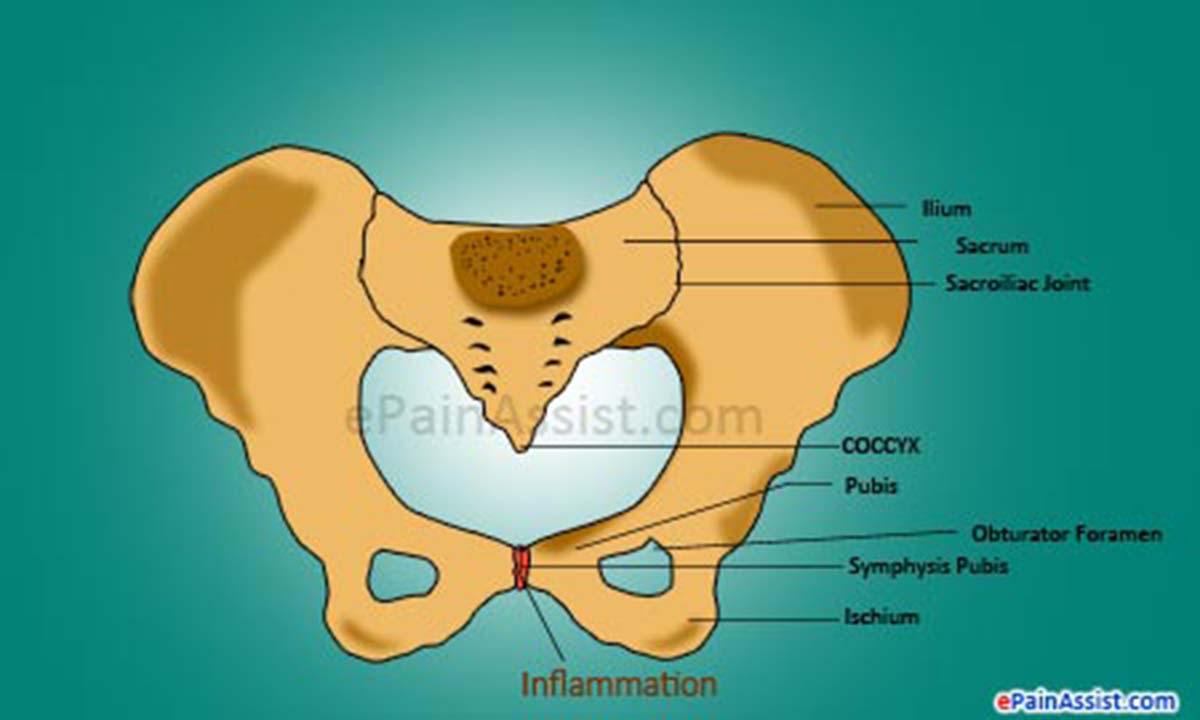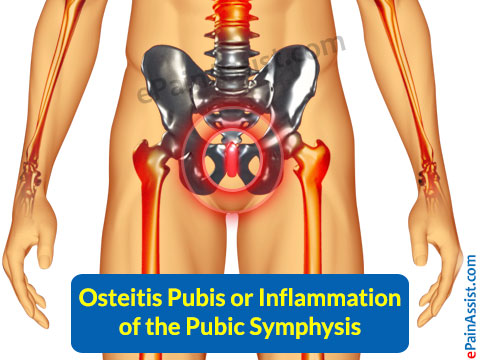Osteitis pubis[1] is also known as noninfectious inflammation of the pubis, noninfectious inflammation of the symphysis pubis or noninfectious inflammation of the pubic symphysis.
Osteitis pubis is an overuse type of injury which is characterized by inflammation of the pelvis at the connecting site of two pubic bones i.e. pubic symphysis and tissue damage that results in groin pain.
The pelvis is built up of two bones known as right hemipelvis and left hemipelvis which connect together at the front side of the pelvis at the pubic symphysis. The pubic symphysis is built up of a cartilage that works like a cushion and helps in absorbing forces between the two bones. There are many muscles that connect near the pubic symphysis such as the abdominals and the adductors. Contraction of these muscles such as while kicking, performing sit-ups and running may exert a pulling force on pubic symphysis. Excessive forces resulting from high force and too much repetition leads to damaging of symphysis and pubic bones. When pubic symphysis becomes inflamed, which generally happens due to such reasons, it is called as osteitis pubis.

Excessive contraction of abdominal muscles such as while performing repetitive sit-ups and inadequate rehabilitation followed by a previous adductor injury like adductor tendinopathy [2]may also result in osteitis pubis.
Risk Factors and Causes of Osteitis Pubis (Inflammation of the pubic symphysis)
Osteitis pubis is an overuse injury that is caused by performing repetitive and long term activities that strain the pubic symphysis. Osteitis pubis may affect while kicking, repetitive running and activities that involve changing of directions. Osteitis pubis is very frequent in running sports like hockey, athletics specifically in marathon runners and football.
Other Causes of Pubic Symphysis Inflammation May Include:
- Inadequate rehabilitation followed by a previous adductor injury.
- Training on hard and uneven ground.
- Improper training technique.
- Increase in training frequency and intensity.
- Inadequate warm up.
- Poor posture.
- Poor biomechanics.
- Muscle weakness, particularly of the core stabilizers, adductors and gluteals.
- Dancing and ice skating, where high kicks are performed.
- Muscle tightness, specifically of the hip flexors, abdominals, adductors, gluteals and hamstrings.
- Poor foot posture such as flatfeet.
- Inappropriate footwear.
- Leg length discrepancy.
- Joint stiffness, especially the hip, knee and lower back.
- Poor core and pelvic stability.
- Neural tightness.
- Reduced fitness.
- Muscle imbalances and tightness in the buttocks, hips and groin.
- Fatigue.

Signs and Symptoms of Osteitis Pubis (Inflammation of the Pubic Symphysis)
- Pain and stiffness in the groin which may also increase eventually.
- Pain may also be experienced on either or both the sides of the groin.
- Aggravation of pain by exercises or while performing activities like sit-ups, the activities that involve changing of directions, running and kicking.
- Generally pain is also experienced on firmly touching the pubic bone present at the front side of the pelvis.
- Exacerbation of pain while squeezing the legs together and when the affected leg is moved away from the midline of the body in abduction.
- Occasionally pain may also be experienced at the front side of the hips and in the lower abdominals.
- Waddling or limping may also be experienced due to pain.
Treatment for Osteitis Pubis (Inflammation of the Pubic Symphysis)[3]
The early treatment for osteitis pubis concentrates on preventing the condition to become even more chronic. It is difficult to treat the condition of osteitis pubis as osteitis pubis is a condition which usually does not respond appropriately to treatment due to which the treatment process may go on anywhere from six months to two years.
Bed rest helps in alleviation of pressure on the pubic bone. Resting is obviously required to avoid any further damage or aggravate the condition. Resting period depends upon the severity of the condition. The recovering time in subacute stage can be anywhere from three days to three weeks and the chronic stage may take anywhere from three weeks to two years to recover. Exercises that put strain on pubic symphysis such as kicking or lifting heavy weights should be avoided until the muscles recover.
Ice Therapy: Application of ice to the affected area for about 10 to 15 minutes every two to three hours during the day.
Heat Therapy: Heat therapy is usually done in the subacute stage. This may be done in the form of hot bath anywhere from three days to three weeks depending upon the need.
Medications: Paracetamol or antiinflammatory medications such as ibuprofen, aspirin, and naproxen may help in reducing pain and discomfort. Steroid injections also help in alleviation of pain. Exercises need to be avoided for a couple of weeks after injection.
Orthotics for Pubic Symphysis: Orthotics not only improve gait but also help in avoiding pressure on the pubic symphysis.
Physical Therapy for Osteitis Pubis: Physical therapy for inflammation of pubic Symphysis is important in speeding up the healing process. Physical therapy also decreases the likelihood of recurrences in the future. Physical therapy may include:
- Application of heat and ice.
- Electrotherapy like ultrasound.
- Soft tissue massage, especially to the abductors, adductors, psoas, and abdominals.
- Stretches.
- Dry needling.
- Joint mobilization.
- Using crutches.
- Muscle energy techniques.
- Neural stretches.
- Pilates.
- Hydrotherapy.[4]
- Technique correction.
- Prescription of orthotics and footwear advice.
- Correction of abnormal biomechanics.
- Progressive exercises for improvement of flexibility, strength, balance, core and pelvic stability.
- Antiinflammatory advice.
- Activity modification advice.
- Appropriate plan for return to activity.
Sound waves and ultrasound treatment not only speed up the healing process, but also break down the tissues in order to stretch them which also help in alleviation of pain.
Exercises for Osteitis Pubis (Inflammation of the Pubic Symphysis)
Transversus Abdominis Retraining:
This exercise is performed by lying down on the back. Now, gradually pull the belly button inwards away from the belt line and breathe normally. Make sure that the rib cage remains relaxed and does not elevate while performing this exercise. Muscle contraction should be felt if pressed deeply 2 cm from the bony prominence at the front of the pelvis. Practice holding this muscle at one third of a maximal contraction during everyday activities provided it is pain free and ensuring there is no exacerbation of symptoms. Perform three times regularly.
Adductor Stretch:
This exercise is performed by standing tall with the back straight and feet apart approximately twice the width of the shoulder. Now gently lunge to one side as far as possible by keeping the opposite knee straight until a pain-free stretch is felt. Hold for 15 seconds and release. Repeat four to five times. Perform the same exercise on the opposite side.
Bridging:
This exercise is performed by lying down on the back and standing the legs with knees facing towards the ceiling and feet flat on the floor. Gradually raise the bottom by pushing it with the help of feet in order to bring the hip, shoulder and knee in a straight line by tightening the bottom muscles. Hold the position for about two seconds until a pain free stretch is felt. Repeat 10 times.
Tests to Diagnose Osteitis Pubis (Inflammation of the Pubic Symphysis)
A complete subjective and physical examination is performed to diagnose osteitis pubis. Other tests that help in diagnosing and assessing the severity may include:
- X-ray.
- MRI.
- Bone scan.
- CT scan.
